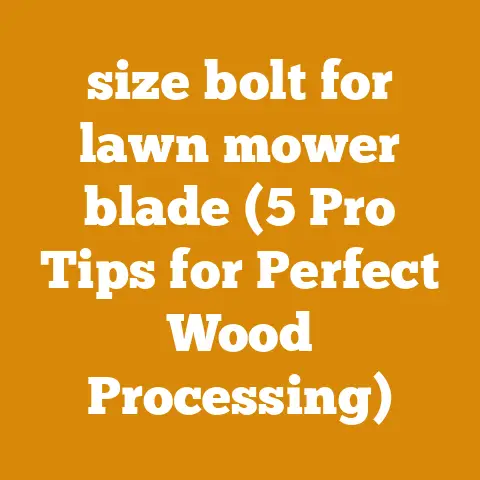Chainsaw Bars and Chain Selection (Pro Tips for Optimal Cutting)
Ever wondered why some chainsaw users seem to slice through wood like butter while others struggle, even with the same saw? The secret often lies in understanding chainsaw bars and chain selection. I’ve spent years in the woods, felling trees and processing firewood, and I can tell you firsthand that choosing the right bar and chain can make all the difference. It’s not just about power; it’s about precision, efficiency, and safety. Let’s dive into the world of chainsaw bars and chains, unlocking the pro tips that will elevate your cutting game.
Understanding Chainsaw Bars
The chainsaw bar, that seemingly simple piece of metal, is the backbone of your cutting operation. It guides the chain, supports it under load, and influences the type of cuts you can make.
Types of Chainsaw Bars
Over the years, I’ve used just about every type of chainsaw bar imaginable, from limbing on a steep hillside to bucking massive logs in the yard. Each has its strengths and weaknesses.
-
Solid Bars: These are the most common type, made from a single piece of steel. They’re durable, reliable, and suitable for most general cutting tasks. I recommend these for beginners and experienced users alike.
-
Laminated Bars: Constructed from multiple layers of steel welded together, these bars are lighter than solid bars. They’re a good option for smaller chainsaws and users who prioritize weight reduction.
-
Hard-Nose Bars: These have a hardened tip, making them ideal for abrasive cutting conditions, such as cutting dirty wood or near the ground. I’ve used these extensively when clearing storm damage.
-
Sprocket-Nose Bars: These bars feature a sprocket at the tip, which reduces friction and heat, resulting in faster cutting speeds and longer bar life. I find these are great for production cutting.
-
Carving Bars: Short and narrow, these bars are specifically designed for intricate carving work. They allow for precise control and maneuverability.
Bar Length: Matching Saw to Task
Bar length is a critical consideration. It determines the size of the wood you can safely cut. A longer bar allows you to fell larger trees, but it also requires more power and can be more difficult to control.
-
Small Chainsaws (12-16 inches): Ideal for limbing, pruning, and light firewood cutting. These are lightweight and easy to maneuver.
-
Medium Chainsaws (16-20 inches): Suitable for felling small to medium-sized trees and bucking logs for firewood. This is a versatile range for most homeowners.
-
Large Chainsaws (20 inches and up): Designed for felling large trees and heavy-duty cutting tasks. These require significant power and experience.
My Rule of Thumb: Choose a bar length that’s at least two inches longer than the diameter of the wood you’ll be cutting most often. This ensures you’re not constantly burying the bar in the wood, which can be dangerous and inefficient.
Bar Mounts: Compatibility is Key
The bar mount is the part of the bar that attaches to the chainsaw. Different chainsaw brands and models use different bar mount patterns. It’s crucial to ensure that the bar you choose is compatible with your chainsaw.
-
Check Your Owner’s Manual: Your chainsaw’s owner’s manual will specify the correct bar mount pattern for your saw.
-
Use a Bar Mount Chart: Many online resources provide bar mount charts that cross-reference chainsaw models with compatible bar mounts.
-
Consult a Chainsaw Dealer: If you’re unsure, consult a knowledgeable chainsaw dealer. They can help you identify the correct bar mount for your saw.
Personal Experience: I once mistakenly purchased a bar with the wrong mount. It was a frustrating experience that taught me the importance of double-checking compatibility.
Bar Maintenance: Extending Bar Life
Proper bar maintenance is essential for extending the life of your chainsaw bar and ensuring optimal cutting performance.
-
Clean the Bar Regularly: Remove sawdust, pitch, and debris from the bar after each use. This prevents build-up that can cause friction and wear.
-
Check the Bar Rails: Inspect the bar rails for wear and damage. If the rails are worn or uneven, use a bar rail dresser to restore them to their original shape.
-
Lubricate the Bar: Use a high-quality bar and chain oil to lubricate the bar and chain. This reduces friction and heat, extending the life of both components.
-
Flip the Bar: Periodically flip the bar over to distribute wear evenly. This helps prevent the bar from wearing out prematurely on one side.
Pro Tip: I always keep a small wire brush and a bar rail dresser in my chainsaw kit. This allows me to perform basic bar maintenance in the field.
Takeaway: Understanding the different types of chainsaw bars, choosing the correct bar length, ensuring bar mount compatibility, and performing regular bar maintenance are crucial for optimal cutting performance and extending the life of your chainsaw bar. Next up, we’ll explore the nuances of chainsaw chains.
Chainsaw Chain Selection: The Teeth That Bite
The chainsaw chain is the business end of your saw. It’s what actually cuts the wood. Selecting the right chain is crucial for efficient, safe, and enjoyable cutting.
Types of Chainsaw Chains
Just like bars, chains come in various types, each designed for specific purposes.
-
Full-Chisel Chains: These chains have square-cornered cutters that provide the fastest and most efficient cutting. They’re ideal for clean wood and experienced users.
-
Semi-Chisel Chains: These chains have rounded-corner cutters that are more forgiving and less prone to dulling than full-chisel chains. They’re a good choice for dirty wood and less experienced users.
-
Low-Profile Chains: These chains have a smaller cutter profile, which reduces kickback and makes them safer to use. They’re often used on smaller chainsaws and by homeowners.
-
Ripping Chains: These chains are designed specifically for cutting wood along the grain (ripping). They have a different cutter geometry than crosscut chains.
-
Carbide-Tipped Chains: These chains have carbide-tipped cutters that are extremely durable and resistant to dulling. They’re ideal for cutting abrasive materials, such as dirty wood or demolition debris.
Personal Experience: I once used a full-chisel chain to cut a pile of reclaimed lumber. It was incredibly efficient, but the chain dulled quickly due to the dirt and grit embedded in the wood. I learned my lesson and now use a semi-chisel or carbide-tipped chain for that type of work.
Chain Pitch and Gauge: Matching Chain to Saw
Chain pitch and gauge are two critical measurements that determine the compatibility of the chain with your chainsaw bar and sprocket.
-
Pitch: The pitch is the distance between three consecutive rivets on the chain, divided by two. Common pitches include 3/8″ and .325″.
-
Gauge: The gauge is the thickness of the drive links that fit into the groove of the chainsaw bar. Common gauges include .050″ and .058″.
Important: It’s essential to use a chain with the correct pitch and gauge for your chainsaw. Using the wrong chain can damage your saw and be dangerous. Check your owner’s manual or the markings on your bar to determine the correct pitch and gauge.
Drive Links: The Heart of the Chain
The number of drive links determines the length of the chain. You’ll need to know the number of drive links when purchasing a replacement chain.
-
Count the Drive Links: The easiest way to determine the number of drive links is to count them on your existing chain.
-
Check Your Owner’s Manual: Your owner’s manual may also specify the number of drive links for your chainsaw.
-
Consult a Chainsaw Dealer: If you’re unsure, consult a knowledgeable chainsaw dealer.
Chain Sharpening: Maintaining a Sharp Edge
A sharp chain is essential for safe and efficient cutting. A dull chain requires more force, which can lead to fatigue and increase the risk of kickback.
-
Use a Chainsaw File: A chainsaw file is the most common tool for sharpening chainsaw chains. Use a file with the correct diameter for your chain’s cutter size.
-
Use a Chainsaw Grinder: A chainsaw grinder is a power tool that can sharpen chains quickly and accurately.
-
Hire a Professional: If you’re not comfortable sharpening your own chains, you can hire a professional to do it for you.
My Sharpening Routine: I sharpen my chains every time I refuel my chainsaw. This ensures that I’m always cutting with a sharp edge. I use a file for quick touch-ups in the field and a grinder for more thorough sharpening at home.
Chain Tension: Finding the Sweet Spot
Proper chain tension is crucial for safe and efficient cutting. Too loose, and the chain can derail. Too tight, and it can overheat and wear out prematurely.
-
Check the Tension Regularly: Check the chain tension before each use and periodically during use.
-
Adjust the Tension: Adjust the chain tension so that the chain can be pulled away from the bar slightly, but still fits snugly against the bar rails.
-
Hot vs. Cold Tension: The chain will expand as it heats up during use. Adjust the tension slightly looser when the chain is hot.
Pro Tip: I always carry a small screwdriver in my chainsaw kit for adjusting chain tension in the field.
Takeaway: Understanding the different types of chainsaw chains, matching the correct pitch and gauge to your saw, knowing the number of drive links, maintaining a sharp edge through regular sharpening, and ensuring proper chain tension are all essential for safe and efficient cutting. Next, we’ll examine the nuances of selecting the right chain for specific tasks.
Matching Chainsaw Chains to Specific Tasks
The type of wood you’re cutting, the cutting conditions, and your experience level all influence the best chain choice. Let’s break it down.
Softwood vs. Hardwood
-
Softwood (Pine, Fir, Spruce): Softwoods are generally easier to cut than hardwoods. A full-chisel chain can be a good choice for softwood, as it provides fast and efficient cutting. However, a semi-chisel chain will also work well and may be more durable if the wood is dirty.
-
Hardwood (Oak, Maple, Hickory): Hardwoods are denser and more difficult to cut than softwoods. A semi-chisel chain is often a better choice for hardwood, as it’s more durable and less prone to dulling. You may also want to consider a chain with a slightly lower cutter profile for better control.
Personal Insight: I’ve found that oak, in particular, can be tough on chains. When processing oak firewood, I always use a semi-chisel chain and sharpen it frequently.
Clean Wood vs. Dirty Wood
-
Clean Wood: Clean wood is free of dirt, bark, and other debris. A full-chisel chain is a good choice for clean wood, as it provides the fastest and most efficient cutting.
-
Dirty Wood: Dirty wood contains dirt, bark, and other debris that can quickly dull a chain. A semi-chisel or carbide-tipped chain is a better choice for dirty wood, as it’s more durable and resistant to dulling.
Real-World Example: Cutting firewood that has been lying on the ground can quickly dull a chain. I always try to elevate the logs before cutting them to minimize contact with the ground.
Felling vs. Limbing vs. Bucking
-
Felling: Felling involves cutting down a tree. A chain with a longer bar and a higher cutter profile is often used for felling.
-
Limbing: Limbing involves removing branches from a felled tree. A chain with a shorter bar and a lower cutter profile is often used for limbing.
-
Bucking: Bucking involves cutting a log into smaller pieces. The chain choice for bucking depends on the size and type of wood being cut.
Practical Tip: When limbing, be mindful of the potential for kickback. Use a chain with a low-kickback design and maintain a firm grip on the chainsaw.
Experience Level
-
Beginner: If you’re new to using a chainsaw, start with a chain that is easy to control and has a low-kickback design.
-
Experienced User: If you’re an experienced chainsaw user, you may prefer a chain that provides faster and more efficient cutting, even if it requires more skill to control.
Safety First: No matter your experience level, always wear appropriate safety gear, including a helmet, eye protection, hearing protection, gloves, and chainsaw chaps.
Takeaway: Matching your chainsaw chain to the specific task, wood type, cutting conditions, and your experience level will improve cutting efficiency, reduce chain wear, and enhance safety. Now, let’s delve into some advanced techniques and troubleshooting tips.
Advanced Techniques and Troubleshooting
Once you’ve mastered the basics, you can explore some advanced techniques to further optimize your cutting performance.
Chain Filing Techniques: Beyond the Basics
-
Maintaining Consistent Angles: Consistency is key when filing a chainsaw chain. Use a filing guide to maintain consistent angles for the top plate and side plate.
-
Adjusting Depth Gauges: The depth gauges (or rakers) control the amount of wood the cutter takes with each pass. Lowering the depth gauges increases the aggressiveness of the chain, but it also increases the risk of kickback.
-
Understanding Cutter Geometry: Different chain types have different cutter geometries. Understanding the geometry of your chain can help you sharpen it more effectively.
Personal Hack: I use a magnifying glass to inspect the cutters after sharpening. This helps me identify any imperfections and ensure that the cutters are sharp and uniform.
Diagnosing Cutting Problems
-
Chain Smokes or Burns: This indicates that the chain is dull or that the bar is not properly lubricated.
-
Chain Cuts at an Angle: This indicates that the cutters on one side of the chain are duller than the cutters on the other side.
-
Chain Bounces or Vibrates: This indicates that the chain is too loose or that the bar is damaged.
-
Chain Dulls Quickly: This indicates that the chain is being used to cut dirty wood or that the chain is not properly hardened.
Troubleshooting Tip: Before replacing a chain, try sharpening it first. Often, a dull chain is the root cause of many cutting problems.
Optimizing Bar and Chain Lubrication
-
Using the Right Oil: Use a high-quality bar and chain oil that is specifically designed for chainsaws.
-
Checking the Oil Level: Check the oil level regularly and refill it as needed.
-
Adjusting the Oil Flow: Some chainsaws allow you to adjust the oil flow. Increase the oil flow when cutting hardwoods or when using a longer bar.
My Recommendation: I prefer using a vegetable-based bar and chain oil. It’s biodegradable and less harmful to the environment.
Understanding Kickback and How to Prevent It
-
Kickback: Kickback is a sudden, uncontrolled movement of the chainsaw bar that can occur when the tip of the bar contacts an object.
-
Causes of Kickback: Kickback can be caused by pinching the chain in the cut, contacting a knot or other obstruction, or using the tip of the bar to cut.
-
Preventing Kickback: Use a chain with a low-kickback design, maintain a firm grip on the chainsaw, avoid using the tip of the bar to cut, and be aware of your surroundings.
Safety Reminder: Kickback is a serious hazard. Always be aware of the potential for kickback and take steps to prevent it.
Takeaway: Mastering advanced techniques like fine-tuning chain filing, diagnosing cutting problems, optimizing lubrication, and understanding kickback can significantly improve your chainsaw performance and safety. Finally, let’s cover essential safety guidelines.
Essential Safety Guidelines
Using a chainsaw is inherently dangerous. Following these safety guidelines can help prevent accidents and injuries.
Personal Protective Equipment (PPE)
-
Helmet: A helmet protects your head from falling branches and other debris.
-
Eye Protection: Eye protection protects your eyes from sawdust and flying debris.
-
Hearing Protection: Hearing protection protects your ears from the loud noise of the chainsaw.
-
Gloves: Gloves protect your hands from cuts and abrasions.
-
Chainsaw Chaps: Chainsaw chaps protect your legs from chainsaw cuts.
-
Steel-Toed Boots: Steel-toed boots protect your feet from falling logs and other hazards.
PPE is Non-Negotiable: Never operate a chainsaw without wearing all of the required PPE.
Safe Operating Procedures
-
Read the Owner’s Manual: Familiarize yourself with the operation and safety features of your chainsaw.
-
Inspect the Chainsaw: Before each use, inspect the chainsaw for damage or wear.
-
Start the Chainsaw Safely: Start the chainsaw on the ground or on a stable surface.
-
Maintain a Firm Grip: Always maintain a firm grip on the chainsaw with both hands.
-
Keep Your Balance: Keep your balance and footing while operating the chainsaw.
-
Avoid Overhead Cutting: Avoid cutting overhead, as this can be dangerous.
-
Be Aware of Your Surroundings: Be aware of your surroundings and watch out for hazards such as power lines, fences, and other people.
-
Never Cut Above Shoulder Height: Always keep the chainsaw below shoulder height for better control and reduced risk of kickback.
Emergency Preparedness
-
First Aid Kit: Keep a well-stocked first aid kit on hand.
-
Communication Device: Carry a cell phone or other communication device in case of emergency.
-
Emergency Plan: Have an emergency plan in place in case of an accident.
Hope for the Best, Prepare for the Worst: It’s always better to be prepared for an emergency than to be caught off guard.
Avoiding Common Mistakes
-
Cutting with a Dull Chain: A dull chain is more dangerous than a sharp chain.
-
Overreaching: Overreaching can cause you to lose your balance and control of the chainsaw.
-
Cutting in Unsafe Conditions: Avoid cutting in wet or windy conditions.
-
Working Alone: Working alone can be dangerous in case of an accident.
Learn from Others’ Mistakes: Pay attention to the mistakes that others have made and learn from them.
Takeaway: Prioritizing safety by using appropriate PPE, following safe operating procedures, being prepared for emergencies, and avoiding common mistakes is crucial for preventing accidents and injuries when using a chainsaw.
By understanding chainsaw bars and chain selection, you’re not just making cuts; you’re making informed decisions that enhance your efficiency, safety, and overall experience. Remember, the woods are a powerful place, and respecting that power through knowledge and preparation is the key to a long and fulfilling journey with your chainsaw. Now, get out there and put these pro tips to work!






